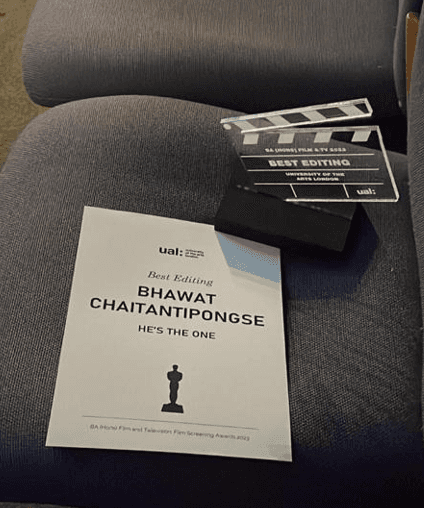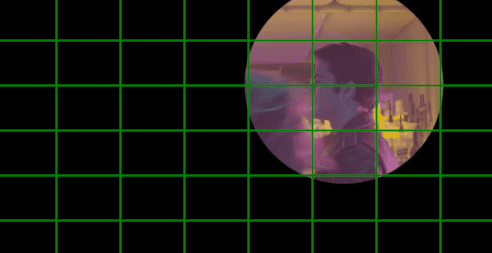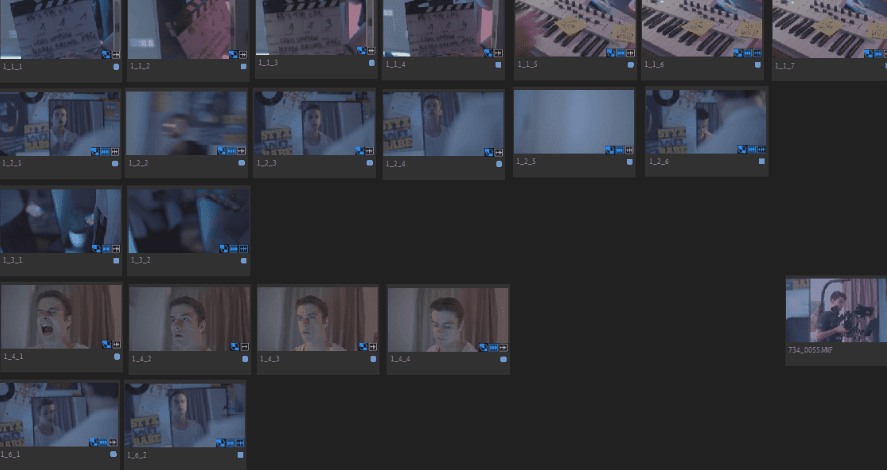He's The One

Accolades: Best Film Editor for Film & Television 2023 Screening at UAL
Project Overview
Aaron and his best friend Raya head on a night out to their regular queer bar. While there, Aaron meets the man of his dreams, Connor. It’s love at first sight for Aaron.
He's The One

Accolades: Best Film Editor for Film & Television 2023 Screening at UAL
Project Overview
Aaron and his best friend Raya head on a night out to their regular queer bar. While there, Aaron meets the man of his dreams, Connor. It’s love at first sight for Aaron.
He's The One

Accolades: Best Film Editor for Film & Television 2023 Screening at UAL
Project Overview
Aaron and his best friend Raya head on a night out to their regular queer bar. While there, Aaron meets the man of his dreams, Connor. It’s love at first sight for Aaron.
Process
Process
Process
Editing a musical is an intricate art that demands a deep understanding of music, rhythm, and storytelling. As an editor, I embarked on the task of crafting a seamless and captivating musical experience, encountering challenges that requires adaptation and the responsibility of learning new techniques.
One of the major hurdles I encountered was mastering the technique of mickey-mousing, an editing method where the visuals are synchronized with the music down to the smallest nuances. This technique, often employed in musicals, aims to accentuate the emotional impact and enhance the storytelling experience. It involves synchronizing on-screen actions, gestures, and movements to the musical score, creating a tight and seamless connection between sound and visuals. Adjusting to mickey-mousing was undoubtedly a complex task. It required me to possess an acute sense of timing and a deep understanding of the beats per minute (BPM) and intentions of the music. I had to meticulously analyze each scene and break it down into smaller segments to identify precise moments for musical synchronization, which was done through multiple stringouts to play around and test each cut. This process demanded meticulous attention to detail, as even the slightest mistiming could disrupt the desired impact, ultimately throwing off any sort of impact and emotion to the film.
Furthermore, I found myself faced with the task of learning Pro Tools, a popular digital audio workstation used in professional music production. At first, the prospect seemed daunting, but as I delved into the software, I discovered its versatility and functionality.
Learning Pro Tools required a combination of dedication, patience, and a willingness to explore its vast array of features. I started by familiarizing myself with the user interface and understanding the basic functions such as importing and organizing audio files, creating tracks, and applying effects. Alongside the help of my mentor, I began understanding the basics of ProTools workflow, which was tough, but rewarding.
Editing a musical is an intricate art that demands a deep understanding of music, rhythm, and storytelling. As an editor, I embarked on the task of crafting a seamless and captivating musical experience, encountering challenges that requires adaptation and the responsibility of learning new techniques.
One of the major hurdles I encountered was mastering the technique of mickey-mousing, an editing method where the visuals are synchronized with the music down to the smallest nuances. This technique, often employed in musicals, aims to accentuate the emotional impact and enhance the storytelling experience. It involves synchronizing on-screen actions, gestures, and movements to the musical score, creating a tight and seamless connection between sound and visuals. Adjusting to mickey-mousing was undoubtedly a complex task. It required me to possess an acute sense of timing and a deep understanding of the beats per minute (BPM) and intentions of the music. I had to meticulously analyze each scene and break it down into smaller segments to identify precise moments for musical synchronization, which was done through multiple stringouts to play around and test each cut. This process demanded meticulous attention to detail, as even the slightest mistiming could disrupt the desired impact, ultimately throwing off any sort of impact and emotion to the film.
Furthermore, I found myself faced with the task of learning Pro Tools, a popular digital audio workstation used in professional music production. At first, the prospect seemed daunting, but as I delved into the software, I discovered its versatility and functionality.
Learning Pro Tools required a combination of dedication, patience, and a willingness to explore its vast array of features. I started by familiarizing myself with the user interface and understanding the basic functions such as importing and organizing audio files, creating tracks, and applying effects. Alongside the help of my mentor, I began understanding the basics of ProTools workflow, which was tough, but rewarding.


Workflow
Workflow
Workflow
As both the Digital Imaging Technician (DIT) and editor, my video editing workflow involved a seamless integration of tasks from on-set data management to the final editing process.
As the DIT, my primary responsibility was to ensure the smooth handling and organization of digital media on set. I oversaw the transfer of footage from the camera to secure storage devices, verifying data integrity and creating backup copies. I also implemented file name changes to ensure organization, applying necessary corrections and matching the footage for consistency.
Once the shooting phase was complete, I transitioned into the editing phase. This involved importing the footage into Adobe Premiere Pro, and creating a project timeline with multiple stringouts for each scene. I organized the clips into a logical structure, labeling and categorizing them based on scenes, takes, or any other relevant criteria.
During the editing process, I focused on assembling the footage into a coherent narrative. I selected the best takes, trimmed clips for timing and pacing, and arranged them within the sequence. I also applied transitions and special effect techniques to enhance the visual aesthetics of the final product.
After creating a polished timeline, the file was saved and exported to my color grader who used color grading techniques on DaVinci Resolve. In the meanwhile, I collaborated with my sound designer, where we both used ProTools to help make the sound in our musical more emotional. This involved adding atmospheric sounds, non-diegetic sounds, and mixing in the casts vocal singing, by adding layers of different takes. Our main inspiration from this is the mixing of Celine Dion's vocals from 'My Heart Will Go On'.
As both the Digital Imaging Technician (DIT) and editor, my video editing workflow involved a seamless integration of tasks from on-set data management to the final editing process.
As the DIT, my primary responsibility was to ensure the smooth handling and organization of digital media on set. I oversaw the transfer of footage from the camera to secure storage devices, verifying data integrity and creating backup copies. I also implemented file name changes to ensure organization, applying necessary corrections and matching the footage for consistency.
Once the shooting phase was complete, I transitioned into the editing phase. This involved importing the footage into Adobe Premiere Pro, and creating a project timeline with multiple stringouts for each scene. I organized the clips into a logical structure, labeling and categorizing them based on scenes, takes, or any other relevant criteria.
During the editing process, I focused on assembling the footage into a coherent narrative. I selected the best takes, trimmed clips for timing and pacing, and arranged them within the sequence. I also applied transitions and special effect techniques to enhance the visual aesthetics of the final product.
After creating a polished timeline, the file was saved and exported to my color grader who used color grading techniques on DaVinci Resolve. In the meanwhile, I collaborated with my sound designer, where we both used ProTools to help make the sound in our musical more emotional. This involved adding atmospheric sounds, non-diegetic sounds, and mixing in the casts vocal singing, by adding layers of different takes. Our main inspiration from this is the mixing of Celine Dion's vocals from 'My Heart Will Go On'.






Skills
Skills
Creativity
Efficient use of Adobe Premiere Pro & After Effects
Collaboration
Quick-learning
Creativity
Efficient use of Adobe Premiere Pro & After Effects
Collaboration
Quick-learning